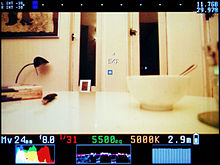
A digital single-lens reflex camera is a digital camera that combines the optics and mechanisms of a single-lens reflex camera with a solid-state image sensor and digitally records the images from the sensor.

The Canon EOS 5D is a 12.7 megapixel digital single-lens reflex (DSLR) camera body produced by Canon. The EOS 5D was announced by Canon on 22 August 2005, and at the time was priced above the EOS 20D but below the EOS-1D Mark II and EOS-1Ds Mark II in Canon's EOS digital SLR series. The camera accepts EF lens mount lenses.
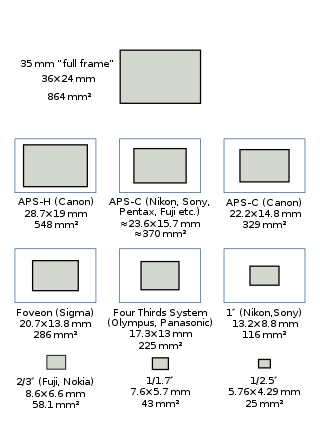
A full-frame DSLR is a digital single-lens reflex camera (DSLR) with a 35 mm image sensor format. Historically, 35 mm was one of the standard film formats, alongside larger ones, such as medium format and large format. The full-frame DSLR is in contrast to full-frame mirrorless interchangeable-lens cameras, and DSLR and mirrorless cameras with smaller sensors, much smaller than a full 35 mm frame. Many digital cameras, both compact and SLR models, use a smaller-than-35 mm frame as it is easier and cheaper to manufacture imaging sensors at a smaller size. Historically, the earliest digital SLR models, such as the Nikon NASA F4 or Kodak DCS 100, also used a smaller sensor.

Live preview is a feature that allows a digital camera's display screen to be used as a viewfinder. This provides a means of previewing framing and other exposure before taking the photograph. In most such cameras, the preview is generated by means of continuously and directly projecting the image formed by the lens onto the main image sensor. This in turn feeds the electronic screen with the live preview image. The electronic screen can be either a liquid crystal display (LCD) or an electronic viewfinder (EVF).

Digital Imaging Integrated Circuit is Canon Inc.'s name for a family of signal processing and control units for digital cameras and camcorders. DIGIC units are used as image processors by Canon in its own digital imaging products. Several generations of DIGICs exist, and are distinguished by a version number suffix.

The Canon EOS 500D is a 15-megapixel entry-level digital single-lens reflex camera, announced by Canon on 25 March 2009. It was released in May 2009. It is known as the EOS Kiss X3 in Japan, and as the EOS Rebel T1i in North America. It continues the Rebel line of mid-range DSLR cameras, is placed by Canon as the next model up from the EOS 450D, and has been superseded by the EOS 550D (T2i).

The Canon EOS 7D is a high-end APS-C digital single-lens reflex camera made by Canon. It was announced on 1 September 2009 with a suggested retail price of US$1,699, and was marketed as a semi-professional DSLR camera.
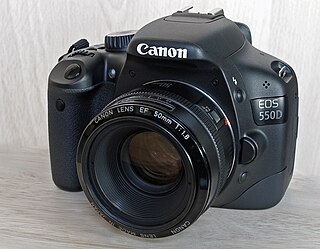
The Canon EOS 550D is an 18.0-megapixel digital single-lens reflex camera, announced by Canon on 8 February 2010. It was available since 24 February 2010, and to US dealers from early March. It is known as the EOS Kiss X4 in Japan, and as the EOS Rebel T2i in the Americas. It is part of Canon's entry- / mid-level digital SLR camera series, and was the successor model to the EOS 500D. It was succeeded by the EOS 600D but remained in Canon's lineup until being discontinued in June 2012 with the announcement of the EOS 650D.

The Canon EOS 60D is an 18.1 megapixels semi-pro digital single-lens reflex camera made by Canon. It was announced on August 26, 2010, with a suggested retail price of US$1099.00. As a part of the Canon EOS two-digit line, it is the successor of the EOS 50D and is the predecessor of the EOS 70D.

Magic Lantern is a firmware add-on for various Canon digital single-lens reflex (DSLR) cameras and the EOS M. It adds features for DSLR filmmaking and still photography, and is free and open-source.

The Canon EOS-1D X is a professional digital SLR camera body by Canon Inc. It succeeded the company's previous flagship Canon EOS-1Ds Mark III and the Canon EOS-1D Mark IV. It was announced on 18 October 2011.

The Canon EOS 5D Mark III is a professional-grade 22.1 megapixel full-frame digital single-lens reflex (DSLR) camera made by Canon.
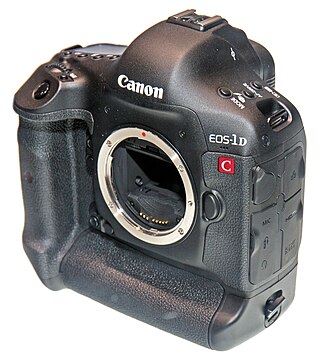
The Canon EOS-1D C is an 18.1-megapixel CMOS digital single-lens reflex camera made by Canon in the Cinema EOS range. It shares many features with the Canon EOS 1D X. It was publicly announced on April 12, 2012, and was released in March 2013 with suggested retail price of US$15,000. The Canon EOS-1D C is stated to be the world's first 4K resolution DSLR camera.
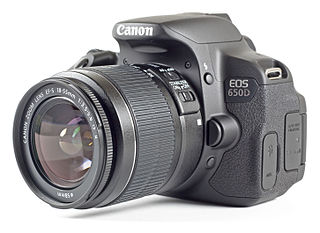
The Canon EOS 650D, known as the Kiss X6i in Japan or the Rebel T4i in America, is an 18.0 megapixels digital single-lens reflex camera (DSLR), announced by Canon on 8 June 2012. It is the successor of the EOS 600D/Kiss X5/Rebel T3i and is the predecessor of the EOS 700D/Kiss X7i/Rebel T5i. Sales began on 15 June 2012. At introduction, recommended retail prices for the body were US$849.99, £699.99, and €839.99.
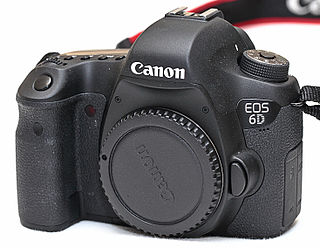
The Canon EOS 6D is a 20.2-megapixel full-frame CMOS digital single-lens reflex camera made by Canon.

The Canon EOS 7D Mark II is a professional digital single-lens reflex camera made by Canon. It was announced on September 15, 2014 with a suggested retail price of US$1,799. It features a 20.2 effective megapixel APS-C CMOS sensor, Full HD video recording at 60 fps, 10.0 frames per second continuous shooting, a 100% accuracy viewfinder that offers 1× magnification. It also features a 65-point auto-focus system, a built-in Speedlite transmitter and a new 150k RGB pixels + IR metering sensor. It was preceded by the Canon EOS 7D.

The Canon EOS 5DS and EOS 5DS R are two closely related digital SLR cameras announced by Canon on February 6, 2015. Both are professional full-frame cameras with 50.3-megapixel sensors, the highest of any full-frame camera at the time of announcement. The only difference between the two models is that the sensor of the "R" version includes an optical filter that cancels out the effects of a standard optical low-pass filter. This distinction is roughly similar to that between Nikon's now-replaced D800 and D800E. Canon stated that both the 5DS and 5DS R will not replace the older EOS 5D Mark III; therefore, both the 5DS and 5DS R will have their new positions in Canon's DSLR camera lineup.
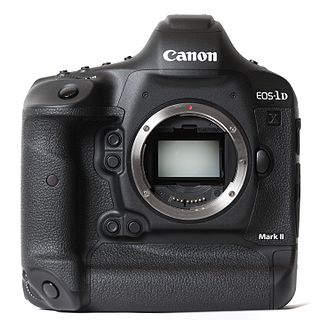
The Canon EOS-1D X Mark II was the company's 20-megapixel full-frame DSLR flagship camera, announced on February 1, 2016, by Canon with an MSRP of US$5,999.00. It is the successor to the Canon EOS-1D X, which was released in 2012.

The Canon EOS 5D Mark IV is a professional-grade 30.1-megapixel full-frame digital single-lens reflex (DSLR) camera made by Canon.

The Canon EOS 250D is a 24.1 megapixel digital single-lens reflex camera (DSLR) made by Canon. It was announced on 10 April 2019 with a suggested retail price of €549. It is also known as the EOS Kiss X10 in Japan and the EOS Rebel SL3 in North America and the EOS 200D Mark II in Australia and Asia.



